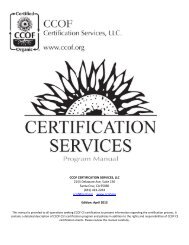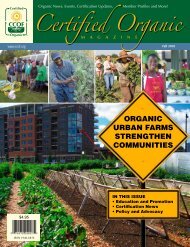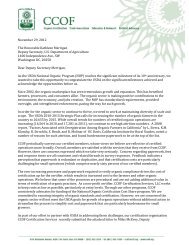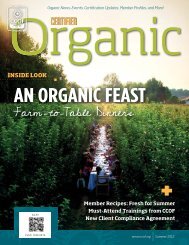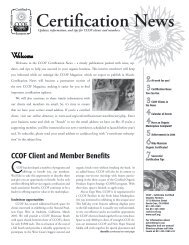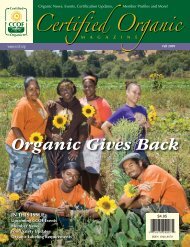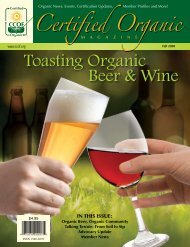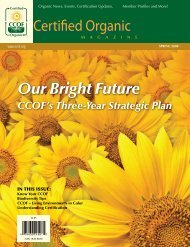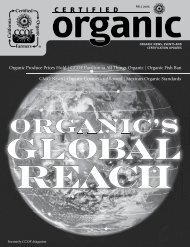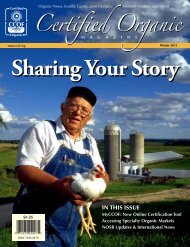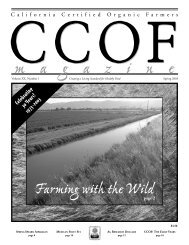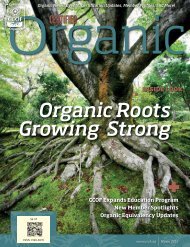Herstory: Women in Organic Agriculture - CCOF
Herstory: Women in Organic Agriculture - CCOF
Herstory: Women in Organic Agriculture - CCOF
You also want an ePaper? Increase the reach of your titles
YUMPU automatically turns print PDFs into web optimized ePapers that Google loves.
under NOP section 205.204 (a) (1) (2),<br />
therefore conventional crowns may be<br />
used but should not be treated with any<br />
prohibited materials <strong>in</strong> the handl<strong>in</strong>g of the<br />
plant material. If the crowns are from a<br />
non-organic source, complete OSP Section<br />
G 3.1.<br />
The same pr<strong>in</strong>ciple would apply to propagants<br />
such as sweet potato slips; you may<br />
use untreated commercial plant material (if<br />
organic is not available) as a mother plant<br />
on an organic operation. The mother plant<br />
would be managed organically to multiply<br />
the seedl<strong>in</strong>gs.<br />
COMPOST AND MANURE<br />
Q: What k<strong>in</strong>ds of compost products are<br />
A<br />
allowed under the Federal Rule?<br />
: OSP Section G 4.1, Part B, “If you<br />
Purchase Compost…”<br />
Compost that met the old <strong>CCOF</strong> standard<br />
will meet the new USDA regulation.<br />
While compost must be handled <strong>in</strong> accordance<br />
with NOP Section 205.203 (c) (2),<br />
under the head<strong>in</strong>g “Soil Fertility and Crop<br />
Nutrient Management Practice Standard”,<br />
<strong>CCOF</strong> anticipates that the National<br />
<strong>Organic</strong> Standards Board (NOSB) will pass<br />
recommendations that will provide further<br />
explanation for the compost regulations.<br />
The NOSB recommendations will provide<br />
for allowances for vermiculture and<br />
broader carbon to nitrogen ratios. The<br />
standards for compost are also outl<strong>in</strong>ed <strong>in</strong><br />
OSP Section 4.1, Part A. If compost does<br />
not conta<strong>in</strong> manures, then it is not regulated<br />
by the Federal Rule and would be<br />
considered mulch.<br />
Q: Can I use processed manure products<br />
A<br />
on my organic operation?<br />
: OSP Section G 4.1, Part A and/or B,<br />
“If You Produce Compost…” or “If You<br />
Purchase Compost…”<br />
Yes, heat-treated manures or processed<br />
manures may be used as they are treated to<br />
prevent the contam<strong>in</strong>ation of crops with<br />
pathogens. Aga<strong>in</strong>, <strong>CCOF</strong> anticipates that<br />
the NOSB will approve language that provides<br />
clarification as to the use of processed<br />
manures.<br />
Q: Are graz<strong>in</strong>g animals considered to<br />
A<br />
be a raw manure application?<br />
: No, <strong>CCOF</strong> is not consider<strong>in</strong>g that<br />
graz<strong>in</strong>g animals are subject to the restrictions<br />
of raw manure application. <strong>CCOF</strong><br />
seeks to encourage the use of animals <strong>in</strong><br />
crop rotations; however, we do not encourage<br />
the use of graz<strong>in</strong>g animals <strong>in</strong> crops that<br />
are harvested for fresh consumption. Clearly<br />
animals are not grazed <strong>in</strong> vegetable crops<br />
prior to harvest.<br />
Q: How do I know if my compost is<br />
A<br />
contam<strong>in</strong>ated with Clopyralid?<br />
: OSP Section G 4.1, Part B, “If You<br />
Purchase Compost…”<br />
If you are buy<strong>in</strong>g compost, you should<br />
ask the compost producer to provide evidence<br />
that they test for Clopyralid residue.<br />
If you cannot verify that such a test has been<br />
conducted, you should perform an on-farm<br />
bioassay. For directions on perform<strong>in</strong>g the<br />
bioassay, see The Newsletter of <strong>CCOF</strong>, Vol.<br />
19, No. 1, pages 10–12 (Spr<strong>in</strong>g 2002). You<br />
can f<strong>in</strong>d this article on the <strong>CCOF</strong> website at<br />
www.ccof.org/nl/nl10-12.pdf, or e-mail the<br />
Statewide Office at ccof@ccof.org to request<br />
a copy of the article <strong>in</strong> PDF format (you can<br />
download Adobe Acrobat Reader to view<br />
PDF files from the <strong>CCOF</strong> website at<br />
www.ccof.org). We can also send you a copy<br />
via fax or U.S. Mail.<br />
MATERIALS & PRODUCTION MANAGEMENT<br />
Q: Can I use copper on my organic<br />
A<br />
farm?<br />
: Yes. Be sure to complete the correct<br />
portions of the OSP.<br />
• For use as a micronutrient: OSP Section<br />
G 4.2, Part A, “Fertility Inputs…”<br />
• For Pest and Disease Control: OSP<br />
Section G 5.1, Part A, “If you Use<br />
Substances For Controll<strong>in</strong>g Insects<br />
or Diseases…”<br />
Q: Can I still use pheromones on my<br />
A<br />
organic farm?<br />
: OSP Section G 5.1, Part A, “If You<br />
Use Substances For Controll<strong>in</strong>g Insects…”<br />
Yes, twist-ties, or hangers can be used; you<br />
should check the OMRI list for approved<br />
pheromone dispens<strong>in</strong>g products. There is<br />
concern that some brand name pheromone<br />
products are at risk of be<strong>in</strong>g dropped from<br />
the OMRI list due to EPA list III <strong>in</strong>ert<br />
<strong>in</strong>gredients, (see the OMRI Brand Names<br />
List on the web at www.omri.org, or go<br />
the <strong>CCOF</strong> website and use the OMRI<br />
l<strong>in</strong>k). However, the NOSB is review<strong>in</strong>g the<br />
<strong>in</strong>ert <strong>in</strong>gredients <strong>in</strong> these cases and there is<br />
a lot of support for keep<strong>in</strong>g these important<br />
products as “approved” under the<br />
USDA Rule.<br />
Summer 2002 Page 27



